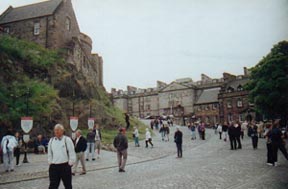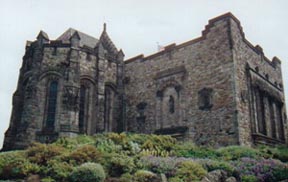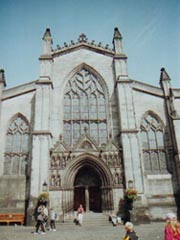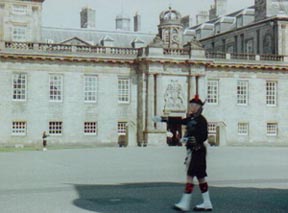
Chapter Three

One of the more interesting experiences during our week was listening to Bruce try to play the bagpipe. We found one in a shop the day we in Edinburgh (pronounced Ed-in-boro). Edinburgh is about 45 miles to the east of Glasgow, located on the Firth of Forth.
Like the rest of Scotland, this incredible city is filled with history, the same characters reappearing as their adventures took them all over Scotland. Here, in Edinburgh Castle, we hear of Robert the Bruce and Mary Queen of Scots. Several poets and writers are remembered in a museum close to the castle - Robert Burns, Sir Walter Scott and Robert Louis Stevenson. The Encyclopedia Britannica was first published as three volumes in this same neighborhood.
We began our day at the castle. This imposing structure sits at the top of a volcanic hill, overlooking every quarter of the city, from the old town with its mysterious history of murder and mayhem, to the Georgian homes of New Town. The castle is built on such a firm foundation, that it has never been defeated by throughout its history. Neither English nor Scotsman could break down the walls using force. There are modern cannons, which are still used today, although for ceremonial purposes. The One O’clock cannon is sounded each day, so that the residents are synchronized to the same time. At some point in history, the leaders even sent maps of the city with the difference in time from the moment the cannon is shot to the time the residents in the furthest areas of the city heard the noise. It takes ten seconds for the sound to reach Leith. Mons Meg is a 15th century cannon which on display in the castle. This extremely large cannon weighs over six tons and was very difficult to relocate. After just a few short years, it was retired from military service and used to fire ceremonial salutes. The cannon was dumped in 1681 when it exploded, but eventually was placed on display in London, and then in Scotland. Once, when the cannon was shot to celebrate the marriage of Mary Queen of Scots, the gunstone was recovered two miles away!
|

The castle is home to several museums, including the Scottish National War Museum. This impressive building was reconstructed from an old barracks and now houses books with all the names of the war dead from Scotland from the wars of the twentieth century. Opened in 1927, the memorial includes a Hall of Honour built upon the highest point of the volcanic stone on which the castle is built. In this lovely shrine is a green marble stone of remembrance with a silver box in which are scrolls with the dead from the first world war.
One of the most exciting displays we visited was the Crown Room, where the Honours of Scotland are on display. There is a crown, scepter and sword, all made in the 16th century. They were first used together at the coronation of the infant Queen Mary, in September 1543. In the 1650’s, when Cromwell was destroying the status quo around the British Isles, the honours were protected. In 1707, they were sealed in the crown room when England and Scotland were unified and rediscovered 111 years later. They are the property of the people of Scotland, and have been on display for nearly 200 years. They are made of gold, silver, pearls and fine gems.
In the same case, protected by the same guards, is an unusual object. Several cubic feet in size, looking rather worn with rough edges and rusted hooks, is a rock. This rock looks so out of place with the other honours, being of little value in our society today. After all, a rock such as this can be found in any quarry or tumbling castle ruin. However, this block of stone is no ordinary rock. It is the Stone of Destiny, and has been used in the coronations of every monarch of England for the past seven hundred years and for all the kings of Scotland for at least four hundred years before that. The monarch sat upon this stone, or above this stone, during the coronation ritual. There is something about its power that has great meaning to the people. Edward I removed it in 1296. It was taken to London and stored in Westminster Abbey. It was returned to the people of Scotland in 1996, however it will be used for the coronations of any future monarch.
The history of this stone is unknown. There are some that say the stone’s importance goes even further back into history, perhaps even to the days of Iron Age man. There are others who say that the rock is a fake, of no real value at all. However, it stands in the Crown Room of Edinburgh Castle, more valuable than all the gold and gems of the regalia of the kingdom.
We ate a delicious meal of baguettes filled with meats and cheeses while we sat overlooking the Firth of Forth and the City of Edinburgh. From there we could see the park where Hogmanay, the New Year’s Celebration is held. In the shop, we bought the usual array of guidebooks and postcards. We also purchased a miniature bottle of The Bruce Scotch Whiskey.
Bruce is a very popular Scottish name, with the king Robert the Bruce being one of the most popular heroes. Whiskey is just popular. I do not know much about whiskey since I do not personally drink it, however a story of Scotland would be incomplete without a mention. Throughout our adventures we passed many distilleries, though we did not find the time to visit any of them. The origins of the distillation process are unknown, however the earliest distillers in Scotland were monks. In the 1500’s whiskey was only sold through a doctor!
The process begins with barley that is malted. This means it is steeped in water for 2-3 days then allowed to germinate on a smooth floor. The germination creates heat, so the barley is turned regularly. After several days it is heated in a kiln, which in the old days were fired by peat. Even today peat is used to add a special flavour to the whiskey. The barley is then milled, mashed and fermented. The fermented liquid is distilled, then stored in barrels for at least three years. The barrels are always recycled, most often having been used for the creation of American bourbon. The flavours of the bourbon and the barrel add to the taste. During the maturation process as much as two percent of the whiskey is lost to evaporation through the walls of the cask. This is called ‘The Angels’ Share’.
Grain whiskey is similar to malt whiskey, though the grain is not malted and creates a lighter flavour. Blended whiskey is the most difficult to make since it is a blend of many different whiskeys which must remain consistent from year to year, or customers will not remain loyal to a brand. Blenders use a mix of malt and grain whiskey to give it the best flavour.
|

As we left the castle, I could not resist a few moments with the gate guards, superbly dressed in their kilts. I approached Gary, one of the handsome young men assigned with this hazardous duty of protecting the castle. I say hazardous because of people like me, always ready with a difficult question or two to keep them on their toes.
“I’m sure you are asked this question about four hundred times a day, but I have to know. What do you wear under that thing?” I said as I pointed at his kilt.
We began the short walk down the Royal Mile, one of the major shopping districts in Edinburgh. We did some window-shopping and even stopped in one or two, seeking souvenirs. We found a shop that sold bagpipes, and we couldn’t resist the chance. Inside the shop, there was bagpipe music playing on the stereo. One clerk agonized over the millionth hearing of a particular song, while the young man sold us a miniature bagpipe. He allowed the children a chance to test it out and get their pictures taken while they held it. He tried to demonstrate its use, and we could immediately tell he was not practiced in the art of bagpipe blowing. But then, there are some people who say that there is no such art - that bagpipe music sounds like… I will let you fill in the blank. I personally enjoy the sound of the music when a master - or anyone other than Bruce plays it - and we found one such man on the Royal Mile. I love to hear the song Amazing Grace played on the pipes.
|

We stopped in St. Giles’ Cathedral, a 12th century church with typically older roots. St. Giles is the patron of lepers and was selected as the name of the church because the Lazarites were given responsibility for it. They were a religious order, which was dedicated to the caring of lepers. The building changed considerably over the years, with the addition of many chapels for prayer. St. Giles was a cathedral of great importance in the town of Edinburgh, central to the people and events throughout history. No event at the cathedral had as much impact of the ministry of John Knox. He was the great Protestant reformer who preached against the pope and against women in the monarchy. Knox was a follower of John Calvin. Many of his followers took his message against popery to be one of iconoclasm. They removed many of the statues in the cathedral, which they sold to pay for other changes. Preaching became the central focus of the worship service, so the layout changed to be more open with seats around the pulpit so all could hear the sermon. The church formed from the reform preached by John Knox became what is known as the Presbyterian Church. He was minister of St. Giles’ from 1560-1572.
The church is simple as is characteristic of Scottish church architecture. The beautiful stained glass windows are relatively new, the earliest window installed in 1872. A later chapel was built in the late 19th century for the Order of the Thistle. This order of knights (or ladies) is given to honour people who have distinguished themselves in public service. There are only sixteen members at a time, though the sovereign may appoint others if warranted. Queen Victoria was the first to assume this right, by appointing her husband Prince Albert.
The chapel holds sixteen stalls for the knights, as well as a place for the sovereign and other royals. Throughout the chapel, intricately carved wood angels and other statues adorn the walls and ceilings and each of the stalls have a shield, which represents the member. Each member wears a green velvet robe and a gold collar that has enameled thistle. Throughout history members had to pay for their place in the Order of Thistle, but that has been abolished. They must provide their own shield, and if they do not have one, they can apply to have one created. This beautiful chapel stands as a testament to the unselfish service of the members today as well as those throughout history.
|

Our time was running short, so we quickly walked the rest of the Royal Mile to the queen’s Edinburgh residence. The Palace of Holyrood has been a favourite residence of the royal family for many centuries, beginning with James IV who transformed this modest abbey guesthouse into a royal palace for his wife Margaret Tudor. Even today, the royal family stays at the Palace when they are visiting Scotland. When we arrived at the gate, w discovered that we were unable to enter to see the inside because Queen Elizabeth is in residence. One of our goals while living in England is to have some form of sustenance at each of the queen’s homes, so we sat by the gate and ate a chocolate bar. She had spent the day at Inverness, so was not around to greet us. In the shop where we purchased a number of books and postcards, we discovered that she would be in Balmoral on Thursday.
Our walk to the car took us past Holyrood Park, one of the most amazing royal parks. This 640 acre park in the middle of Edinburgh has lochs and its own mountain. King Arthur’s Seat, the highest point of the park, is 823 feet above sea level. There are a number of hikes through the park which give the visitor a chance to see a variety of wildlife and geological features.
|
Chapter Six - Chapter Seven - Chapter Eight - Chapter Nine